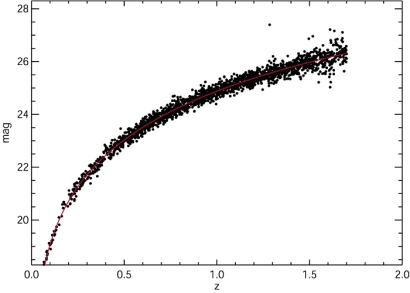is that it's an explanation based on a very long string of knowledge and inferences.
1) Stars moving away from us have red-shifted optical absorption and emission spectra.
2) Certain kinds of stars are "standard candles" and have the same total light emission "integrated intensity" no matter where they are in the universe.
3) g = G m1 m2/(r12^2) describes the gravitational and dynamical behavior of things with mass from things larger than subatomic particles to things larger than galaxy clusters.
4) Gravity bends space-time
5) There are well-understood signals that shows whether light from far-distant stars has been changed (bent, absorbed and re-emitted) on its way to us.
The accelerating expansion of the universe (which is taken as the signature for "dark energy") is based on #2 - standard candles. There's a lot of evidence that that does work, but maybe there are some details yet to be worked out. (It's obviously more complicated than the $0.05 summary here, and far beyond my limited knowledge.)
Maybe something like WIMPs are still the best explanation for what's going on. But I think it's dangerous for us to assume that that's the only possible explanation. "Premature optimization" in programming is a mistake. Premature exclusion of alternate paths of investigation in physics is a mistake, too.
Huge efforts have been put into making fusion tokamaks without much success. More effort on stellarators might have allowed more progress. Maybe!
We make much faster progress with a broad and deep effort in basic physics research, rather than a few expensive "moon shot" efforts that starve everything else. We need both the sexy "moon shot" things and the more "pedestrian" grind it out efforts for basic knowledge.
Cheers,
Scott.
(Who is still too sleepy to wrap his head around the philosophy stuff. ;-)
1) Stars moving away from us have red-shifted optical absorption and emission spectra.
2) Certain kinds of stars are "standard candles" and have the same total light emission "integrated intensity" no matter where they are in the universe.
3) g = G m1 m2/(r12^2) describes the gravitational and dynamical behavior of things with mass from things larger than subatomic particles to things larger than galaxy clusters.
4) Gravity bends space-time
5) There are well-understood signals that shows whether light from far-distant stars has been changed (bent, absorbed and re-emitted) on its way to us.
The accelerating expansion of the universe (which is taken as the signature for "dark energy") is based on #2 - standard candles. There's a lot of evidence that that does work, but maybe there are some details yet to be worked out. (It's obviously more complicated than the $0.05 summary here, and far beyond my limited knowledge.)
Maybe something like WIMPs are still the best explanation for what's going on. But I think it's dangerous for us to assume that that's the only possible explanation. "Premature optimization" in programming is a mistake. Premature exclusion of alternate paths of investigation in physics is a mistake, too.
Huge efforts have been put into making fusion tokamaks without much success. More effort on stellarators might have allowed more progress. Maybe!
We make much faster progress with a broad and deep effort in basic physics research, rather than a few expensive "moon shot" efforts that starve everything else. We need both the sexy "moon shot" things and the more "pedestrian" grind it out efforts for basic knowledge.
Cheers,
Scott.
(Who is still too sleepy to wrap his head around the philosophy stuff. ;-)

